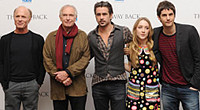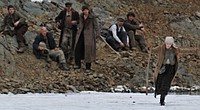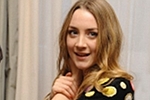 The hard way
The hard way Peter Weir puts Jim Sturgess, Colin Farrell, Ed Harris and Saoirse Ronan through their paces • Page 1 of 2

At the press junket: Harris, Weir, Farrell, Ronan and Sturgess


21.Aug.44 • Sydney


COLIN FARRELL
31.May.76 • Dublin





 Shot almost entirely on location, Peter Weir's epic The Way Back follows a group of 1930s gulag escapees who trek thousands of miles from Siberia to India. Sitting down in London with Weir and his cast members, they all look cool and relaxed. When they start talking about making this film, they are talking as professional actors discussing their craft. Then they start remembering the cold. And the heat. And you can see in their eyes that, while each of them clearly relishes the experience, they're glad it's behind them...
Shot almost entirely on location, Peter Weir's epic The Way Back follows a group of 1930s gulag escapees who trek thousands of miles from Siberia to India. Sitting down in London with Weir and his cast members, they all look cool and relaxed. When they start talking about making this film, they are talking as professional actors discussing their craft. Then they start remembering the cold. And the heat. And you can see in their eyes that, while each of them clearly relishes the experience, they're glad it's behind them...
There's some question about whether the book, The Long Walk by Slawomir Rawicz is factual.
Peter Weir: We use the credit that the movie is "inspired by" the book, and the controversy is whether he was a member of the group that actually made that walk. But he's not with us, he's dead, so for me all I needed to know was that the walk happened. It's true, so then we could fictionalise it, change the title and a few of the characters' names and add vital information gained from interviews with survivors of the gulag system - in Siberia in one case and others in Moscow and with Polish people here in London. Some were obsessed with this "truth" thing, but I didn't want to promise that everything in film - the dialog, characters and their backgrounds - would be exact. But I'm pleased that, down to details in sets, everything you're looking at is true: a reproduction I believe of what it might have been like.
Apparently there were some 7,000 Americans caught in the gulags.
Ed Harris: At least. There was a great book published in 2008 called The Forsaken by Tim Tzouliadis, which was about the thousands of Americans who went to Russia during the Depression. Some of them actually had jobs lined up, some were searching for work, some were Communists, some were socialists, some were just people who were trying to find a job. It was a great book. Peter also had tonnes of research for us to look at, such as documentary footage and that kind of thing.

It's the pure nature of being out in the desert - you drop a few pounds
Colin Farrell: I met Peter subsequent to reading this script. I think I can speak for majority of us in saying that the most exciting prospect of working on this film was to work with Peter. I was such a big fan of his work through the years, and then reading the script I saw Valka as just a big stretch, someone who was incredibly disparate to anything I had approached before. I had no relationship to that time in history or to that country, and so I knew it would be a journey of discovery, and that's what it proved to be. Valka, to this day, is one of my least favourite characters to play. I found him very sad. He's a lonely fellow. He's somebody who is, at once, a victim of and a huge proponent of the system which shaped him. So I found that really, really interesting.
How did you develop a sense of camaraderie?
Ed: We were in Bulgaria a couple of weeks before we started filming. So for part of each day we were working with the dialect coach Valentin Ganev on the Russian language. And we'd get together working on various physical things, whether it was practising milking goats or peeling bark off trees or whatever, taking walks and talking through it with Peter. We also had a great French fellow there, Cyril Delafosse-Guiramand, who had done this walk - not consecutively - and he was really helpful just in terms of what he had gone through, including periods of hallucinating and starvation and that kind of thing. So he talked about the physical aspects of some of that, which was very helpful.
You arrived on set six weeks into production. Did that help with creating the character, who also arrives later on?
Saoirse Ronan: Yeah, about six weeks in, something like that, and it was something that I'd never really experienced before because I had always started a film with everyone else at the start of shooting. And so I was a little bit nervous about it because I didn't know anyone. They had gotten to know each other but, luckily, they made me feel welcome, so it wasn't any trouble at all.
Was it nice to have a countrywoman on set?
Colin: Yeah, more than just being Irish, to have a female energy join the gang six, seven weeks in. We were kind of sick at looking at each other at that stage and it was a welcome relief to have Saoirse come on. It was an absolute treat having her there.
It's a clever use of locations as the settings in the story.
Peter: The various locations played parts in the film. So Bulgaria played the part of Siberia, and the Sahara the Gobi. I love locations. They're like characters in the story.
How were the locations?
Jim Sturgess: We were blessed that it was the most chronological it could have been. We started in the mountains of Bulgaria, which was the gulag, which was great because the proper bonds were being made at that time and I remember that first scene walking into the gulag, feeling fairly isolated with a lot of foreign languages being spoken around me and not really knowing where I was and what was ahead of me. And then as we went through the journey those experiences were shared, and we were able to lose weight along the way - well it's the pure nature of being out in the desert in that heat and the flies - it was enough to make you drop a few pounds.
It looks like Ed lost the most weight.
Ed: Well, I got as lean as I could and still have the energy to do my job. One of the great things about the shoot was that the harder it got and the more difficult the days were - whether walking through waist-deep snow or walking up a sand dune, which is virtually impossible to walk up very quickly, especially when dragging that sled behind you - the more difficult it was physically during the day working, the more you felt like you were doing your job, so it was really helpful. It snowed when we needed it to snow, and we actually had a sandstorm on the day we were going to create the sandstorm. So having to deal with the elements and being out in the open like that just enriched the whole experience. It was great, and the locations were just fantastic to work in.

I just threw in a few slips and falls.
It was good fun
Saoirse: I did! Basically, all I had to do was run across this beautiful fake ice that they had made for the scene. Was it wax? It looks amazing - it was so great. But I just threw in a few slips and falls. It was good fun.
What was the biggest challenge of shooting in these locations?
Colin: Well, I didn't have to deal with any heat; it was just freezing cold in Bulgaria. We arrived there in the middle of winter and it was dark by about 3 in the afternoon. And Sofia was covered in three feet of snow. We started off shooting in the gulag, which they replicated and built to extremely painful detail. It was beautiful as we were looking at it, as a piece of art and something that was going to allow our story to begin to unfold. And as much as you could reach into your imagination and get a sense of what it would have been like to inhabit such a seemingly inhabitable place for 10 or 25 years, you take the cold that you feel on the day and you multiply it by infinity as much as you can. The environment certainly did a lot of the work. There was one particular shot that was about 400 feet and I think we ran out about three roles of film - it took us about 70 minutes! You had a bunch of actors who were really struggling and going, "Are we nearly there?" and praying to hear "cut". So it did a lot of the work for you, and it smashed the line between reality and fiction at moments. But I say that with absolute respect for the level of comfort that we still worked within. We still only worked 12- or 14-hour days and there was never a cup of tea too far away from where we were working.
Peter: And Colin did eat the caterpillars.
Colin: Yes I did! In the last shot. That's right. I didn't name them though.

HOME | REVIEWS | AWARDS | NEWS | FESTIVAL | Q&A | ABOUT | TALKBACK